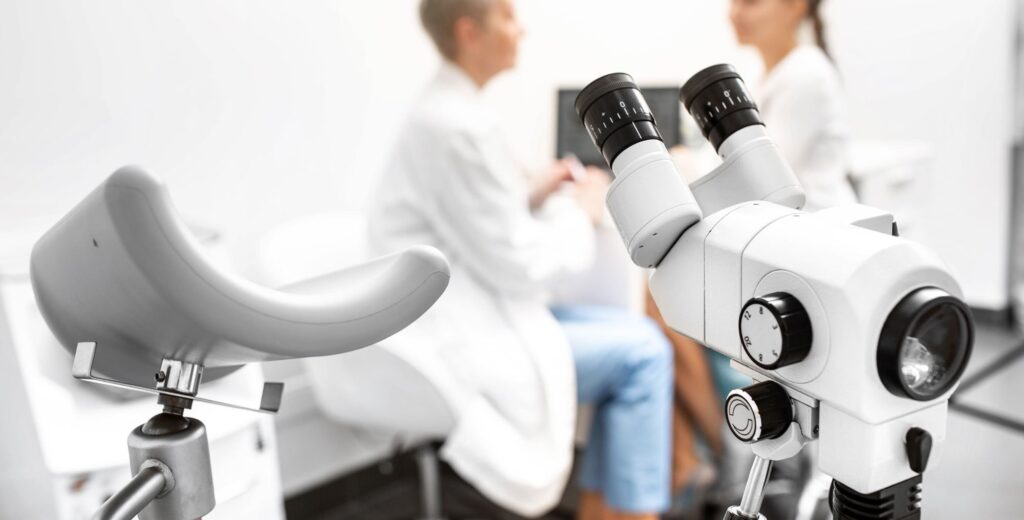Cervical cancer is a type of cancer that develops in the cells of the cervix, the lower part of the uterus that connects to the vagina. Cancer of the cervix is more commonly seen in women over the age of 30 and rarely before. It can cause irregular bleeding but usually leads to postcoital bleeding. It is normally diagnosed by a simple examination and sometimes by a smear test. Occasionally the use of an ultrasound is needed.

Types of Cervical Cancer
-
Squamous Cell Carcinoma:
- Origin: Starts in the thin, flat cells lining the outer part of the cervix.
- Prevalence: Most common type, accounting for about 70-90% of cervical cancers.
-
Adenocarcinoma:
- Origin: Begins in the glandular cells that line the cervical canal.
- Prevalence: Accounts for 10-20% of cervical cancers.
-
Adenosquamous Carcinoma:
- Combination: Contains both squamous and glandular cancer cells.
- Prevalence: Less common.
Causes and Risk Factors
-
Human Papillomavirus (HPV) Infection:
- Primary Cause: HPV, especially high-risk types like HPV-16 and HPV-18, is responsible for the majority of cervical cancer cases.
- Transmission: Sexually transmitted.
-
Other Risk Factors:
- Smoking: Increases the risk of cervical cancer in women with HPV.
- Immunosuppression: Weakened immune system (e.g., due to HIV).
- Multiple Sexual Partners: Increases the likelihood of acquiring HPV.
- Early Sexual Activity: Early exposure to HPV.
- Long-term Use of Oral Contraceptives: Slightly increases risk.
- Family History: Genetics may play a role.
Symptoms
Early stages of cervical cancer often have no symptoms. As the cancer progresses, symptoms may include:
- Vaginal Bleeding: After intercourse, between periods, or after menopause.
- Unusual Vaginal Discharge: May be watery, bloody, or have a foul odor.
- Pelvic Pain: May occur during intercourse or otherwise.
Diagnosis
-
Pap Test (Pap Smear):
- Purpose: Detects precancerous changes in cervical cells.
- Procedure: Cells are scraped from the cervix and examined under a microscope.
-
HPV DNA Test:
- Purpose: Identifies the presence of high-risk HPV types.
- Procedure: Often done in conjunction with a Pap test.
-
- Purpose: Closer examination of the cervix for abnormal areas.
- Procedure: Uses a special magnifying instrument.
-
Biopsy:
- Purpose: Confirms diagnosis by examining a tissue sample.
- Procedure: Removal of a small sample of cervical tissue.
Treatment
-
Surgery:
- Types: Includes procedures like a hysterectomy (removal of the uterus) or conization (removal of a cone-shaped piece of tissue).
-
Radiation Therapy:
- Purpose: Uses high-energy radiation to kill cancer cells or shrink tumors.
- Approach: External beam radiation or brachytherapy (internal radiation).
-
Chemotherapy:
- Purpose: Uses drugs to kill cancer cells.
- Approach: Often combined with radiation therapy.
-
Targeted Therapy and Immunotherapy:
- Purpose: Uses drugs that specifically target cancer cells or help the immune system fight cancer.
Prevention
-
HPV Vaccination:
- Purpose: Protects against high-risk HPV types.
- Age: Recommended for preteens, but can be given up to age 45.
-
Regular Screening:
- Pap Smear: Starting at age 21, done every 3-5 years depending on age and results.
- HPV Testing: Often starts at age 30, combined with Pap smear.
-
Safe Sexual Practices:
- Condom Use: Reduces the risk of HPV transmission.
- Limiting Number of Sexual Partners: Lowers risk of HPV infection.
-
Smoking Cessation:
- Purpose: Reduces risk for cervical cancer and other health issues.
Prognosis
The prognosis for cervical cancer depends on:
- Stage at Diagnosis: Early-stage cancers have a higher cure rate.
- Treatment: Effective treatments are available, especially if detected early.
- Overall Health: General health can impact recovery and treatment outcomes.
Screening Guidelines (General)
- Ages 21-29: Pap smear every 3 years.
- Ages 30-65: Pap smear and HPV test every 5 years or Pap smear alone every 3 years.
- Ages 65+: Screening may be stopped if regular testing was done over the past 10 years with normal results.
For more detailed information, consult healthcare providers or reputable medical sources.








